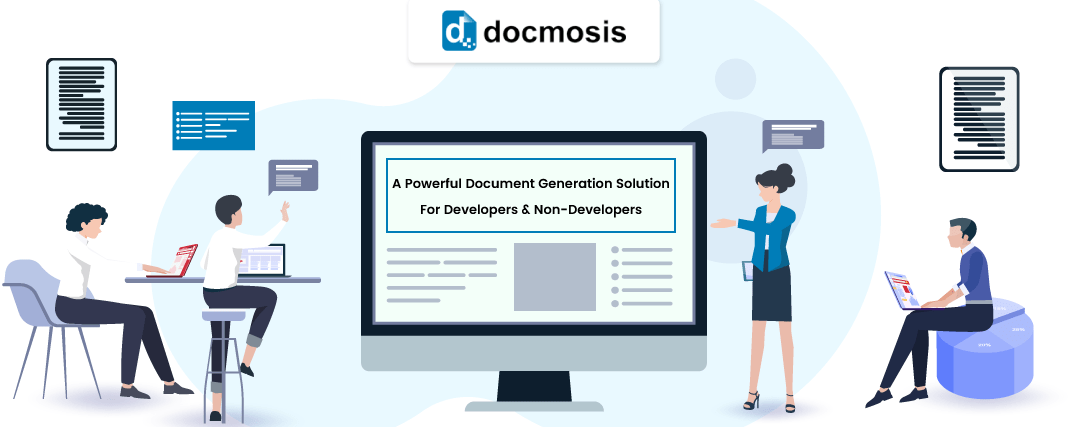
Today, businesses move faster than ever before. Our devices have enabled us to connect quicker. Besides, several integrations help us save time. Moreover, cloud-based tools have given us access to what we need at any time from anywhere. So, when it comes to sharing documents with clients, doing it all manually slows down this fast cycle. Again, it is detrimental to the business’ growth. But what can be done? Well, the answer is simple – get the document generation software.
Undoubtedly, this is the best and ideal solution for every organization dealing with lots and lots of paperwork. Moreover, the availability of hundreds of document generation software makes the process easy breezy, isn’t it? Whoa! If your answer to this is yes, my dear, I’m sorry, but you are under a wrong impression.
One cannot deny the fact that you get several options to choose from while selecting a document generation solution, but always keep in mind – not all document generation software are created equal. So, it is crucial to pick the one that fits your business needs the most.
Wondering how I am so sure about this? Well, I have experienced in my journey to finding a proper DocGen solution to my document generation problems. While I found some free from coding, few were a blend of code and no-code. Anyways, this is just one factor that I mentioned! You will find many others when you set out to pick the right software.
Well, this journey of mine did pause for some time when I came across Docmosis – the document generation software that ensures faster document and reports creation. Enabling organizations to create document templates with MS Word or LibreOffice, Docmosis produces layout documents in the required formats. Additionally, it lets businesses host the solution on the cloud or deploy it on-premises, whichever convenient for the user.
Whether you need to generate contracts, letters, reports, or invoices, Docmosis helps you create them seamlessly. Also, it caters its services to a wide range of industries, including Finance, Insurance, HR, Government, Health, Education, Legal, Manufacturing, and Logistics.
Finding the overview pretty compelling, I decided to delve deeper, and this is what I explored more about it.
An In-Depth Study of Docmosis DocGen Solution
1. Installing Docmosis
As I filled the Free Trial form to take a tour of Docmosis, I was greeted with a few of its technical requirements. First off, it works on computers with LibreOffice. So, I had to install it. Next, they had a couple of steps to follow. All this set-up consumed almost an hour or more of mine – of course, this came along with a number of bumps.
So, at first glance, I found the installation process quite complicated. People with no technical background can find it difficult to catch-up with their installation methods. On the contrary, implementing other DocGen alternatives, I surfed before, were more comfortable.
2. Creating Templates
One thing that makes Docmosis the best is that it requires no plug-ins to create templates on MS Word or LibreOffice.
When it comes to fetching the desired end-result on a document, you need to put placeholders, more popularly known as fields. So, when you run the template, it returns the value of the placeholder you had written. To add placeholders to the template, Docmosis requires you to type it manually. Again, the placeholder follows a specific syntax, i.e., <<field name>>.
Let’s say; you require only creating a template or two. Your entire template demands to insert placeholders twice or thrice. Seems all good with Docmosis, isn’t it? But, what if you are asked to create a complex document that needs you to put multiple placeholders? The same manual method seems time-consuming and frustrating. Again, as the complexity increases, the chance of typos also hikes. For example, <<this(‘text’).get.complex>>. You must ensure that the field you wrote returns a value. Any mistake will not identify the data you want to return and will thus land you in trouble. If you got 100 placeholders, you need to remember all of them.
Moreover, Docmosis has no Office AddIn that can give a list of available fields. If it provides, you can easily match the value you entered with the data and be assured. So, when data structures get complex, Docmosis makes it tricky to build templates. And this is definitely what I would not want my DocGen to lack in.
Besides, it does not assist in cases like how to place conditional statements or add repeating rows in a table. You have to do all on your own, and I found this a significant deficiency of Docmosis as a DocGen tool.
3. Designing Templates
I was in awe when I looked at its templating features. Whether you need to create a single-page letter or complex multi-page reports, including nested tables, table of content, and page numbering, Docmosis offers you several templating features to accomplish your task.
You can embed rules concerning the document layout and formatting in your templates. But it lacks drag and drop functionality. Let’s say; you have some paragraphs that you want to include in multiple templates. What you can do with Docmosis is copy those blocks of content to a Word document, and then paste it in your template as and when needed. You need to repeat this every time you require those paragraphs in your template. Moreover, shuffling between tabs takes up time as compared to solutions that provide drag and drop feature. Besides, this approach never lets you update the inserted paragraphs when you need them.
4. Writing Queries
With Docmosis, querying the data you need for your template can be challenging. As it requires you to use third-party tools to write queries by selecting the data, you don’t expect any assistance from them on this part. If you do not use any tools for querying data, you have to write it manually. So eventually, you will require a developer for the process.
Undoubtedly, you will get many tools for the purpose, but finding Query Wizard as is available in Windward is quite difficult.
5. The Need for Programming
As Docmosis requires a programmer for selecting the data, it has programming tied to every template. This makes the document generation process even more difficult. What a programmer then needs to do is determine the structure of data that will be passed to Docmosis.
This isn’t that troublesome for templates sharing the same data, but if templates use varying data, it gets complicated way beyond your imagination. Your programmer has to write code for each building every different data and then tie it to the template. Well, the process doesn’t end here. It goes to pushing the code changes through QA and staging it to make them live. So, what does this mean? Simple, you need a programmer for every template you design. So, if you are someone like me who lacks programming skills, Docmosis is not something you can operate on your own.
Functionalities that Docmosis Poses & What Other Alternatives have
One major benefit that I can’t stop praising Docmosis for is its ability to mix data from multiple data sources, and that too, in the way you want. Only a few of its competitors have this advantage.
Though Docmosis lacks the ability to enable you to write your own macros, it comes with 50 in-built macros. All of them are sufficient to suffice your everyday document generation needs. Don’t ever require writing macros? Docmosis is excellent for you!
Similar to other DocGen alternatives, Docmosis lets you import templates and process them. While it has no exceptional support to handle styling, it is okay if it provides what you want.
Docmosis render barcodes as images. This is actually better than those solutions using fonts for the same purpose.
Popularly called as tags in other systems, Docmosis’ field list is very limited. It comes with forEach, if, import, link, and out fields.
The following are the data types that Docmosis support seamlessly – text, HTML, images, barcodes, structured string arrays, XML, JSON, POJOs, and SQL ResultSet.
You can generate documents in the given format with Docmosis – DOC, DOCX, HTML, ODT, PDF, and RTF.
Final Words
Docmosis comes with major benefits like letting you mix data from multiple data sources and in-built macros that complements your document generation needs. Moreover, it supports rendered barcodes that any product-selling organization would love to have. But, when it comes to working with Docmosis, it works only on LibreOffice. So, it supports only what LibreOffice supports.
While Docmosis functions only with DOC or DOCX and not PPTX or XLSX, you need to continue your search for document generation tools that support Excel and PowerPoint along with Word.
With a lack of functionalities like AddIns, Drag-and-Drop Doclets, Query Wizards, Tag Tree, Data Count, Debuggers, and more, Docmosis would be something I would keep on my list but as a last option.
You can learn more about Docmosis from its website or its SoftwareSuggest Profile Page.
Need Any Technology Assistance? Call Pursho @ 0731-6725516




